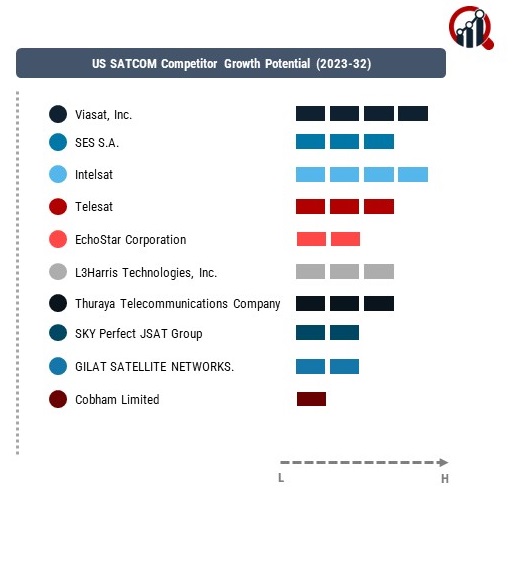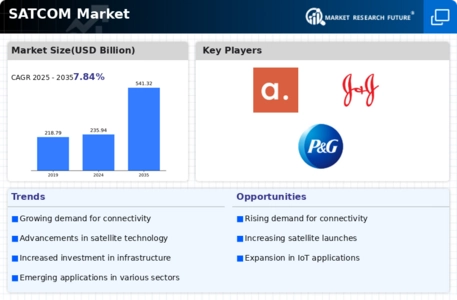Top Industry Leaders in the US SATCOM Market

US Satellite Communication (SATCOM) Market
The US Satellite Communication (SATCOM) market has witnessed significant growth and evolution, driven by technological advancements, increasing demand for high-speed data connectivity, and the expanding space exploration initiatives. As the industry continues to thrive, it is essential to analyze the competitive landscape to understand the key players, strategies adopted, market dynamics, and emerging trends shaping the future.
Key Players and Market Share Analysis:
Viasat, Inc.
SES S.A.
Intelsat
Telesat
EchoStar Corporation
L3Harris Technologies, Inc.
Thuraya Telecommunications Company
SKY Perfect JSAT Group
GILAT SATELLITE NETWORKS.
Cobham Limited
Strategies Adopted by Key Players: The key players in the US SATCOM market have adopted strategic initiatives to maintain their competitive edge and expand their market presence. One common strategy involves continuous investment in research and development to innovate and enhance satellite technologies. Additionally, strategic partnerships and collaborations with other industry leaders, government agencies, and international organizations play a crucial role in fostering growth and global market penetration. Furthermore, these companies focus on offering integrated solutions, combining satellite communication with other advanced technologies such as artificial intelligence and IoT, to provide comprehensive services to their clients.
Factors Influencing Market Share: Several factors contribute to the dynamics of market share within the US SATCOM industry. Technological innovation and the ability to provide reliable, high-speed connectivity are paramount in influencing customer preferences. The adaptability of satellite systems to evolving communication standards, such as 5G, also plays a pivotal role. Moreover, regulatory compliance, security features, and cost-effectiveness are crucial considerations for both commercial and government clients when selecting SATCOM providers. Companies that align their offerings with these factors are better positioned to capture and retain a larger market share.
New and Emerging Companies: While established players dominate the US SATCOM market, a wave of new and emerging companies is entering the scene, bringing innovation and agility. SpaceX, founded by Elon Musk, has disrupted the market with its Starlink project, aiming to create a global satellite internet constellation. OneWeb is another emerging player focusing on deploying a large-scale satellite constellation to provide broadband services globally. These companies challenge the traditional market dynamics, offering competitive alternatives and driving established players to adapt and evolve.
Industry News and Trends: The US SATCOM industry is dynamic, with constant developments and trends shaping its trajectory. Notably, the increasing demand for satellite-based broadband services, driven by remote work requirements and the proliferation of connected devices, has fueled the expansion plans of key players. The push towards smaller and more cost-effective satellites, coupled with advancements in reusable rocket technology, has lowered launch costs and accelerated satellite deployment. Additionally, the industry has witnessed a surge in government contracts for secure and resilient SATCOM systems, reflecting a growing emphasis on national security.
Current Company Investment Trends: Investment trends within the US SATCOM market reflect the industry's growth potential and the strategic priorities of key players. Capital expenditures are predominantly directed towards research and development initiatives to stay ahead in the technological curve. Companies are also investing in upgrading existing satellite fleets and developing next-generation systems to meet the evolving demands of connectivity. Strategic acquisitions and partnerships are on the rise, allowing companies to enhance their capabilities, expand service portfolios, and enter new market segments.
Overall Competitive Scenario: The overall competitive scenario in the US SATCOM market is characterized by a delicate balance between established industry leaders and innovative newcomers. While traditional players maintain their dominance with extensive infrastructure and experience, the influx of new entrants is reshaping the market landscape. The competitive dynamics are further intensified by the global nature of satellite communication, requiring companies to navigate international regulations and collaborate on a broader scale. The industry's future competitiveness will be shaped by the ability of companies to adapt to technological shifts, form strategic alliances, and address evolving customer needs in an ever-changing landscape.
US SATCOM market as of October 26, 2023:
M&A and Investments:
- Viasat acquires Inmarsat: This major acquisition in April 2023 is anticipated to strengthen competition and drive innovation in the market. It creates a powerful new player with broader capabilities and reach.
- Telesat secures C$3 billion in funding for LEO constellation: This substantial investment in August 2023 will support Telesat's Lightspeed low-earth orbit (LEO) constellation launch, aiming to compete with established players like Starlink.
Contract Wins and Partnerships:
- Cobham Satcom chosen for US Navy SATCOM upgrade: In February 2023, Cobham secured a major contract to provide user terminals for the US Navy's Next Generation Wideband service using Inmarsat's Global Xpress network.
- Anuvu partners with Telesat for LEO constellation antennas: This agreement in February 2023 strengthens Telesat's LEO plans and showcases potential commercial applications for the network.
Technological Developments:
- SES launches high-performance multi-orbit service: In February 2023, SES partnered with ThinKom and Hughes to offer a unique service combining different satellite orbits for government aerial missions.
- Viasat unveils next-generation Ka-band satellite: In June 2023, Viasat announced its ViaSat-3 Ultra HD satellite, promising significantly higher capacity and faster speeds.
Regulatory Landscape:
- Competition and Markets Authority (CMA) clears Viasat-Inmarsat acquisition: The CMA's approval in September 2023 paves the way for the deal to complete and its impact on the market to unfold.










